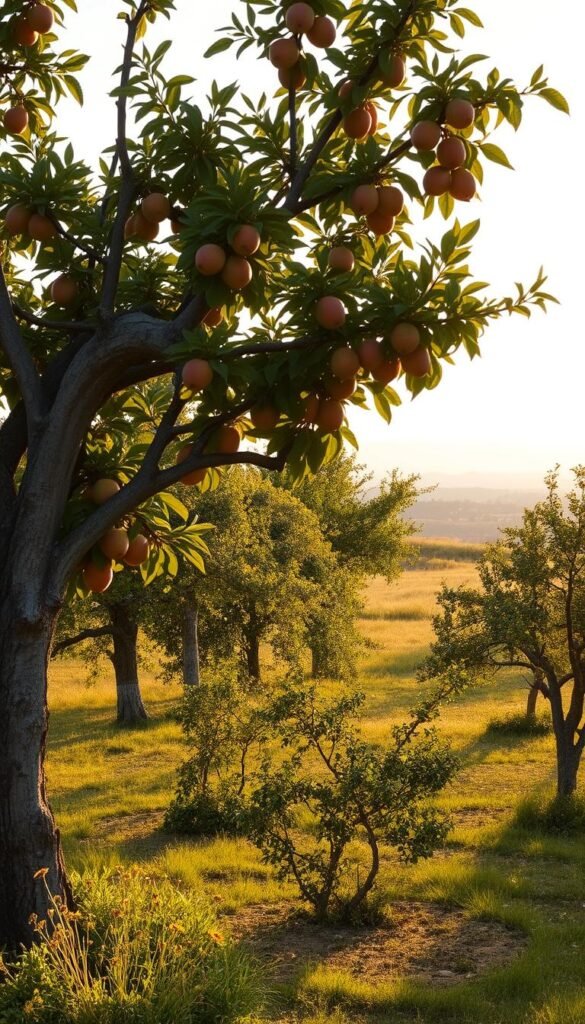Imagine stepping outside to pick sun-warmed peaches or crisp apples from trees you nurtured yourself. A thriving edible landscape isn’t just for farms—it’s possible even in modest yards. With smart planning, that unused patch of grass can become a productive paradise bursting with flavor.
You don’t need vast acreage to grow delicious crops. A compact 15×15-foot area supports 4–6 carefully chosen trees. The secret? Prioritize dwarf varieties and vertical gardening solutions to maximize every square foot. Unlike sprawling commercial setups, home growers focus on quality over quantity, ensuring each plant thrives.
Success starts below ground. Test your soil’s pH and nutrient levels, then amend it as needed. Pair this with strategic pruning to maintain manageable heights and improve airflow. Selecting disease-resistant types suited to your climate reduces headaches later.
Picture plucking juicy berries or tart cherries mere steps from your kitchen. This approach blends practicality with pleasure—you’ll enjoy fresh snacks while creating a vibrant habitat for pollinators. Ready to swap lawn care for harvest baskets? Let’s dig into the essentials.
Understanding the Basics of Backyard Fruit Garden Design
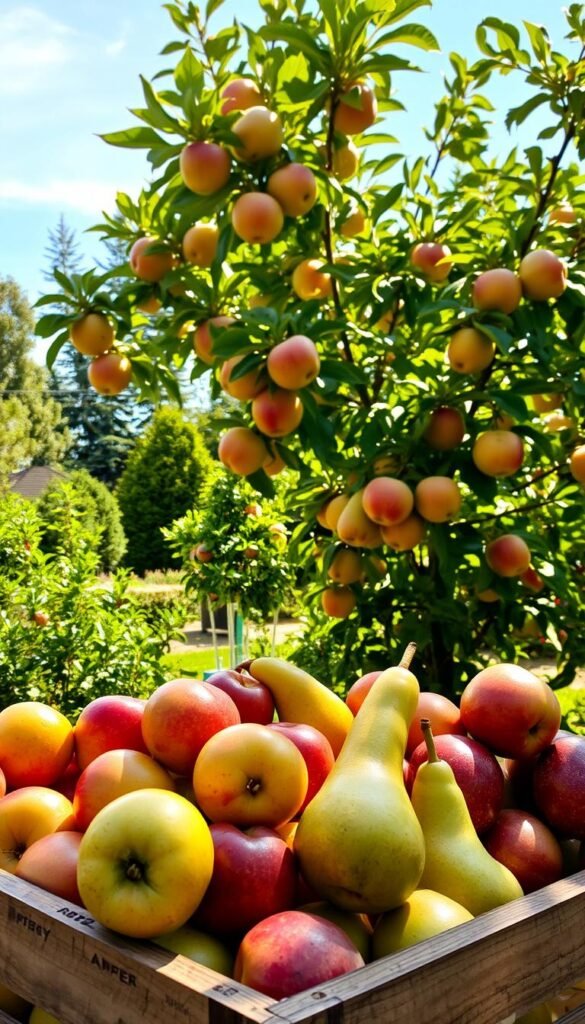
Fresh snacks growing just outside your door might sound like a fantasy, but modern growing methods make it achievable. With smart techniques, even small spaces become productive zones bursting with flavor and color.
Why Grow Your Own Sweet Rewards?
Nothing beats biting into a juicy peach still warm from the sun. Homegrown crops offer intense flavors that supermarkets can’t match. You control what goes into your food – no mystery chemicals, just pure farm-to-table goodness.
Four to six compact trees can keep your kitchen stocked all season. Imagine jars of homemade jam from summer berries or autumn pies from your own apples. Plus, you’ll save money while eating premium-quality produce daily.
Essential Components for Success
Start by choosing space-saving varieties that thrive in tight quarters. Dwarf trees stay under 8 feet tall yet produce full-sized crops. Pair them with vertical supports to create edible walls that save ground space.
Three critical steps ensure success:
- Test soil acidity and nutrients before planting
- Group plants with similar sun/water needs
- Prune strategically for better air circulation
With hundreds of varieties bred for confined areas, you can mix favorites like crisp apples with exotic options like Asian pears. Your edible oasis becomes a living grocery store that gets better each year.
Planning and Layout for Your Mini Orchard
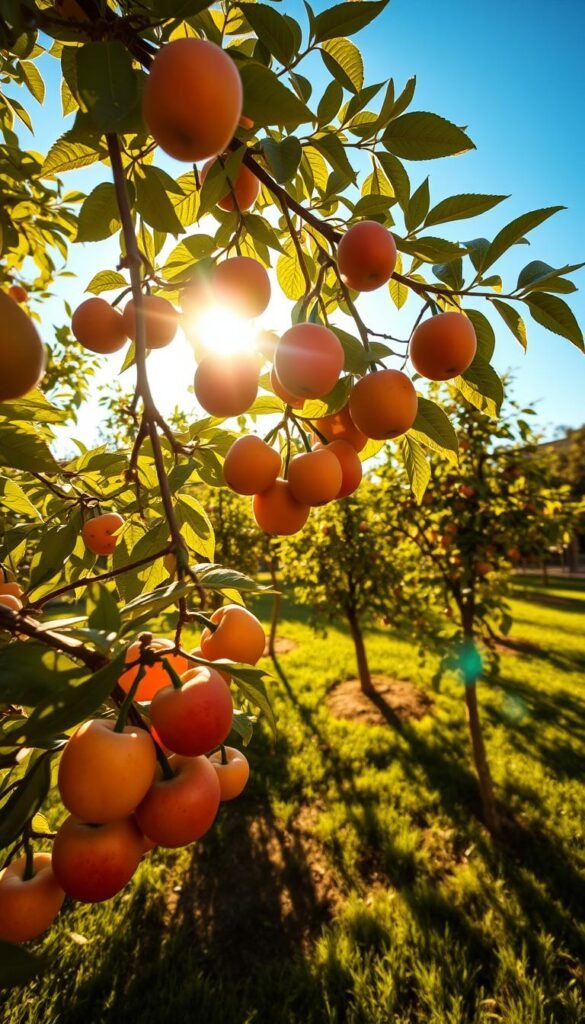
Sunlight is the lifeblood of any thriving edible landscape. Before digging your first hole, spend a week observing how light moves across your planting area. Those golden rays determine whether you’ll get plump peaches or sparse, sour harvests.
Assessing Space, Sunlight, and Slope
Most productive varieties demand 6-8 hours of direct sunlight daily. Use a free sun-tracking app or mark shadows with stakes every two hours. South-facing spots typically win the light race, but east/west exposures work if unobstructed.
Watch for afternoon shade from buildings or mature trees—it’s the #1 yield killer. Gentle slopes help prevent waterlogging, while steep grades might need terracing. “A 5% incline improves drainage better than any French drain,” notes arborist Lisa Chen.
Creating a Functional and Aesthetic Design
Map your trees’ mature sizes on graph paper first. Leave 10-15 feet between standard varieties, 6-8 feet for dwarfs. Stagger rows diagonally to boost light penetration and create visual flow.
Mix rounded canopies with columnar shapes for texture. Frame views with smaller trees up front, taller ones behind. Add curved pathways lined with berries for both access and charm. Your edible haven should delight the eye as much as the palate.
Backyard Fruit Garden Design: Transform Your Lawn into a Lush Orchard
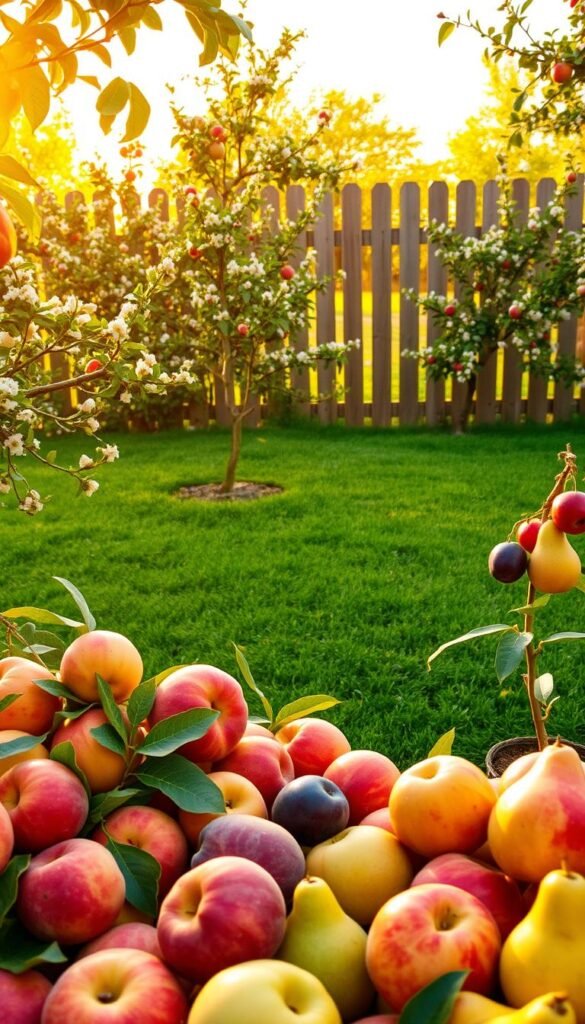
Local wisdom transforms good harvests into great ones. Breeders now craft compact trees tailored to thrive in specific climates, from humid southern zones to chilly northern regions. Your secret weapon? Regional knowledge that turns potential pitfalls into bumper crops.
Tap Into Local Growing Wisdom
Your county’s extension office holds golden advice for choosing disease-resistant varieties that laugh at local pests. One call connects you to decades of trial data—like knowing which apple types shrug off cedar rust in Missouri or which peach cultivars handle Georgia’s humidity.
Three regional factors shape success:
- Last frost dates dictating bloom times
- Soil pH preferences for each variety
- Native pollinators active in your area
Smart Succession Strategies
Stagger planting dates like a pro. Early-season strawberries give way to mid-summer raspberries, followed by autumn-bearing blueberries. For trees, mix ‘Gala’ apples (July) with ‘Fuji’ (October) for three months of crisp snacks.
Modern breeders work magic—they’ve created cherry trees needing 300 chill hours instead of 800. These innovations let gardeners in warm zones enjoy crops once deemed impossible. Pair these new stars with heirloom favorites for a nine-month harvest calendar.
Selecting the Perfect Fruit Trees and Varieties
The secret to a thriving edible space lies in smart plant selection. Focus on varieties that deliver big flavors without demanding endless care. Let’s explore how to choose champions that’ll flourish in your unique conditions.
Space-Saving Superstars
Dwarf trees pack full-sized harvests into compact forms. A semi-dwarf apple tree reaches just 12-15 feet—perfect for tight spots. These smaller versions yield the same juicy apples as their towering cousins but need 30% less space.
Prioritize disease-resistant types to slash maintenance. ‘Liberty’ apples shrug off scab and mildew, while ‘Contender’ peaches survive -25°F winters. Grafted trees combine hardy roots with premium fruit branches, giving you the best of both worlds.
Climate Compatibility Check
Your USDA zone dictates which varieties thrive. Citrus trees adore zones 9-11, while most apples need zones 3-8’s chill hours. Check local extension office recommendations—they’ll suggest top performers for your area.
Three factors ensure perfect matches:
- Winter hardiness (peach trees need 500+ chill hours)
- Soil pH preferences (blueberries demand acidic soil)
- Pollination needs (some apples require cross-pollinators)
Southern growers might choose low-chill ‘Anna’ apples, while northerners pick cold-hardy ‘Honeycrisp’. Always double-check a tree’s zone range before planting—it’s the difference between bumper crops and barren branches.
Preparing and Amending Your Soil for Optimal Growth
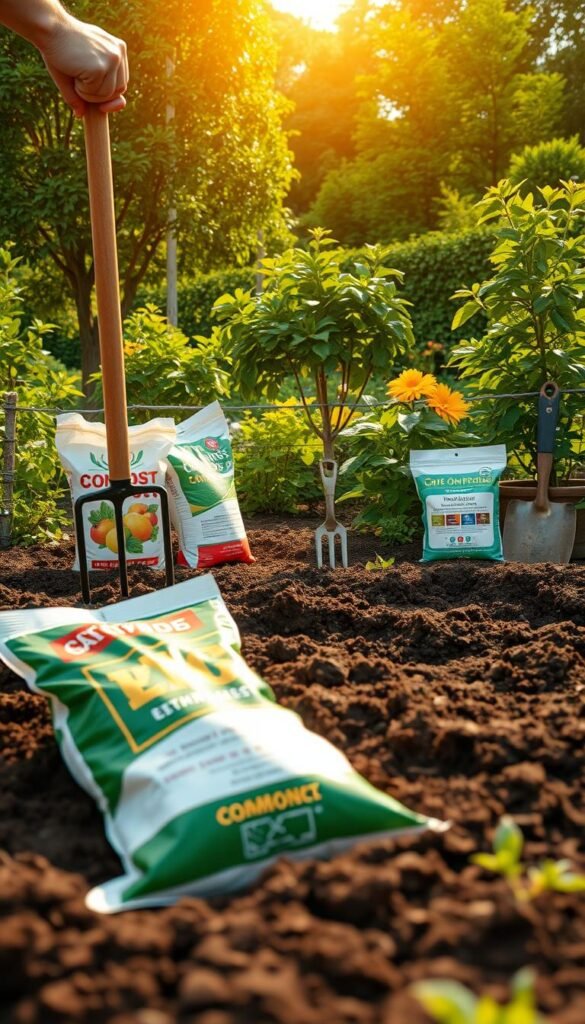
Healthy soil forms the foundation of every thriving edible landscape. While you might think rich compost belongs in planting holes, nature prefers a different approach. Smart techniques help trees establish strong roots while maintaining your soil’s natural structure.
Simple Techniques for Loosening and Top Dressing Soil
Break up compacted earth with a digging fork, working outward from the planting area. This creates pathways for roots to explore without turning the hole into a fluffy trap. “Think of it as gentle encouragement rather than complete renovation,” advises soil scientist Dr. Ellen Park.
Spread 2-3 inches of compost over the surface after planting. These nutrient-rich layers feed the hair-like feeder roots that absorb most moisture and minerals. For heavy clay, mix in coarse sand to improve drainage while keeping soil intact below 12 inches.
Enhancing Soil with Organic Matter and Compost
Annual top-ups with decomposed leaves or worm castings boost microbial activity. Citrus trees demand special care—plant them on 6-inch mounds to prevent soggy roots. Test drainage by digging a 12-inch hole: If water remains after 24 hours, consider raised beds for these sun-loving plants.
Check pH levels every spring using affordable test kits. Most trees thrive in slightly acidic conditions (6.0-6.8), while blueberries need 4.5-5.5. Adjust with sulfur or lime based on results, focusing amendments in the topsoil where roots feed most actively.
Planting Techniques and Essential Maintenance Tips
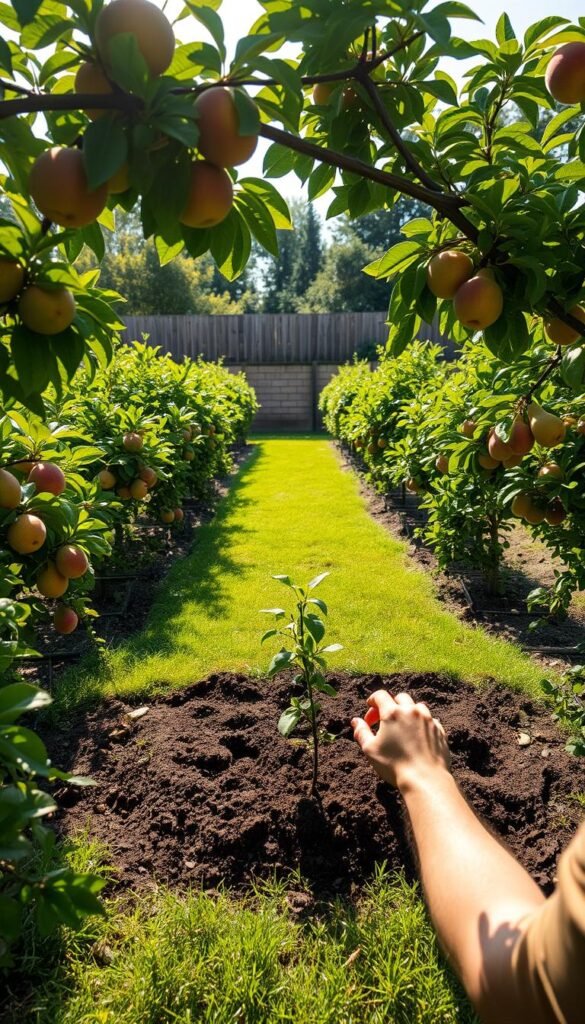
Timing and technique make all the difference when establishing your edible oasis. Mid-spring offers the best time to plant fruit trees, when thawed soil warms to 55°F and frost risks fade. This sweet spot gives roots weeks to settle before summer heat arrives.
Roots Need Room to Breathe
Dig holes twice as wide as the root ball but no deeper. “Burying the graft union smothers the tree’s identity,” warns orchardist Michael Phillips. Keep that knobby spot where roots meet trunk 2-3 inches above ground to prevent rootstock dominance.
Space dwarfs 5-8 feet apart depending on variety. This allows sunlight penetration and easy harvesting. For multiple rows, stagger plants in triangular patterns to maximize airflow. Compact layouts work when you:
- Soak roots in water 2 hours before planting
- Loosen circling roots gently with your fingers
- Backfill with native soil mixed with 10% compost
Water deeply after planting—about 5 gallons per tree. Mulch with wood chips in a 3-foot circle, keeping material 6 inches from trunks. Stake only if your area gets strong winds, using flexible ties that allow slight movement.
Watch for common planting mistakes like over-fertilizing young trees or letting weeds compete. A slow-release organic feed in year two supports growth without burning tender roots. With proper care, your mini orchard will reward you for decades.
Pruning, Fertilizing, and Pest Management for a Healthy Orchard
Maintaining a thriving edible space requires smart care strategies that balance plant health with productivity. Three pillars support this balance: precise pruning, thoughtful feeding, and proactive pest solutions. Let’s explore how these practices work together to create vibrant, fruit-bearing specimens.
Effective Pruning Methods for Compact Growth
Winter’s dormant season offers the perfect window for shaping your trees. Make clean cuts just above outward-facing buds using sharp bypass pruners. This technique encourages horizontal branching where flowers and fruit develop most abundantly.
Follow the 3 Ds rule: remove dead, damaged, or diseased wood first. Then thin crowded branches to let sunlight reach inner leaves. For height control, trim central leaders to 6-8 feet. “Pruning stimulates growth exactly where you want it,” explains arborist Jenna Marlow.
Using Slow-Release Fertilizers and Natural Pest Control
Feed trees in early spring with organic options like feather meal or bone meal. These break down gradually, nourishing plants without causing leafy overgrowth. A balanced 5-5-5 formula supports both root development and fruit production.
| Pest Control Method | Best For | Application Timing |
|---|---|---|
| Neem oil spray | Aphids & mites | Pre-bloom phase |
| Beneficial nematodes | Soil-dwelling larvae | Early spring |
| Companion planting | Repelling beetles | Growing season |
Attract ladybugs and lacewings by planting dill or yarrow nearby. For stubborn infestations, try insecticidal soap sprays during cooler evenings. Always test treatments on a single branch before full application.
Enhancing Fruit Production through Smart Pollination Strategies
The journey from blossom to harvest hinges on one vital process: pollination. Many popular trees—including apples, cherries, and plums—need cross-pollination to produce fruit reliably. Planting compatible varieties within 50 feet creates a thriving ecosystem where blooms become bounty.
Attracting Nature’s Workforce
Bees and butterflies become your secret weapon for abundant harvests. Grow nectar-rich flowers like lavender, coneflowers, and sunflowers that bloom from spring through fall. These living buffets keep pollinators active when your stone fruits and pears need fertilization most.
Taking Matters Into Your Own Hands
When natural helpers are scarce, a small paintbrush becomes your tool for success. Gently transfer pollen between flowers on different trees during dry mornings. This method works wonders for stone fruits like peaches and plums, ensuring each blossom gets its chance to shine.
By combining these approaches, you’ll see more fruits forming where blooms once fell. Remember: Even self-fertile varieties produce fruit more abundantly with pollination partners nearby. Your efforts today lay the groundwork for tomorrow’s sweet rewards.

